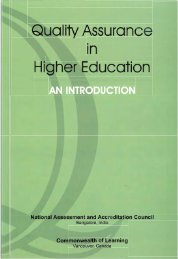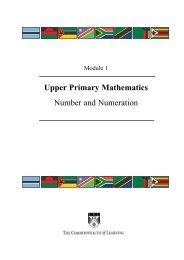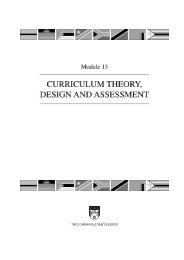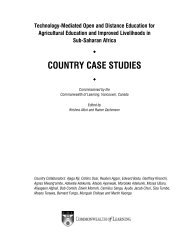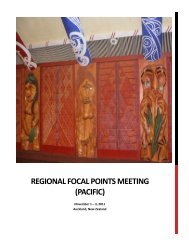Upper Primary Mathematics Fractions - Commonwealth of Learning
Upper Primary Mathematics Fractions - Commonwealth of Learning
Upper Primary Mathematics Fractions - Commonwealth of Learning
Create successful ePaper yourself
Turn your PDF publications into a flip-book with our unique Google optimized e-Paper software.
Division using Set Model<br />
2<br />
Jane has<br />
3<br />
cloth?<br />
4<br />
metres <strong>of</strong> cloth. How many<br />
5<br />
metre pieces can she cut from her<br />
2<br />
(<br />
3<br />
4<br />
÷ )<br />
5<br />
2<br />
3<br />
2<br />
3<br />
4<br />
÷ – The whole set is 15.<br />
5<br />
is 10 counters<br />
4<br />
is 12 counters<br />
5<br />
4 2<br />
How many sets <strong>of</strong> are in ?<br />
5 3<br />
How many sets <strong>of</strong> 10 in set <strong>of</strong> 12?<br />
Are you able to follow?<br />
Reflection<br />
Modelling <strong>of</strong> multiplication and division <strong>of</strong> common fractions seem to be<br />
difficult if not confusing. Do you think it is worth spending time to model<br />
these two operations in common fractions?<br />
1<br />
Draw ÷ 3 by slicing a rectangular whole vertically into two equal parts.<br />
2<br />
Divide the half into three equal parts.<br />
1<br />
2<br />
5<br />
6<br />
÷ 3 =<br />
<strong>of</strong> a set <strong>of</strong> 12<br />
1<br />
6<br />
Figure 3.6: Division using area model<br />
Rather than being given algorithms for division <strong>of</strong> common fractions,<br />
students should be helped to discover the rules on their own.<br />
Module 2: Unit 3 32 Multiplication and Division <strong>of</strong> Common <strong>Fractions</strong>



